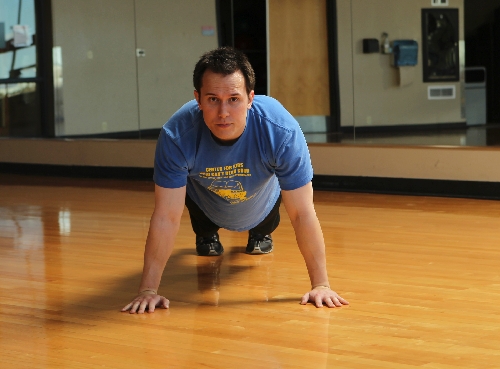Push-ups: A classic, practical exercise for building strength

My editor suggested I do a column on push-ups. So to keep the powers that be on my side, you can read about push-ups today. Besides, as simple as it may be, the basic push-up is an effective exercise, especially when done properly.
Push-ups are a great measure of strength and make a good addition to your favorite exercise circuit. They also are ideal for early teens because they create upper body strength without using heavy weights. They are wonderful for the core because you’re in the plank position for the whole exercise.
The primary muscles worked when doing a push-up are the pectorals, the largest muscles in the chest. Secondary muscles are the triceps and the front of the shoulder. You also will work the entire core as you keep your body in proper position.
Those of you who think you’re too old to do push-ups, think again. I’ve trained people in their 60s to do them when they were convinced the push-up was the only exercise they would never be able to do.
One of the easiest ways to learn to do push-ups is to use the Smith machine (you can find a previous column on this on the R-J website). Start by doing push-ups on the adjustable bar at chest level and then progressively lower it until you can do them on the floor.
Some people find that doing push-ups can cause the wrists to fatigue and hurt from having the palms flat on the floor with the wrists bent. The answer to this problem is to position dumbbells on the floor so they won’t roll. Then grip them keeping the wrists straight while you do your push-ups.
Another alternative is to buy push-up bars or supports, which do the same thing. If you feel your knuckles are sturdy, you can always do push-ups on your fists. This also keeps the wrists straight.
Proper form is important when doing push-ups. It was enough growing up to just do the exercise, never mind how you did it. Becoming a trainer, I found out the safe way to “push up.” It has to do with the shoulders and how they are positioned. When you let the body down, the arms should not be straight out from the body at 90 degrees. This position will force the front of the shoulder to do more work than it should. It could lead to injury.
The arms should be positioned at an angle closer to the body as in the top view of the Spider-Man push-up photo included with today’s column. This form puts the shoulder in a safe place and reduces the amount of lifting the front of the shoulder does.
There are many ways to progress the push-up. One way is the Spider-Man push-up, which works the obliques on the sides of the tummy. You also can do them slowly or on one foot. Another variation is to elevate the feet on a step or plyo box. This will work more of the upper chest.
Turning this basic exercise into a plyometric will be sure to zap your energy level as well as create some impressive power. A plyometric exercise uses the muscles’ natural elasticity in producing force. In this variation, push up with enough power and speed to make your hands come off the ground. Try to clap at the top of each push-up if you feel like showing off. Be sure your plank stays intact. A common mistake is to have the hips pike up and assist in the movement.
Chris Huth is a Las Vegas trainer. You can contact him at 702trainer@gmail.com. Before beginning any exercise program, consult your physician.